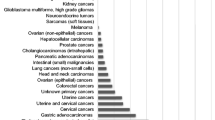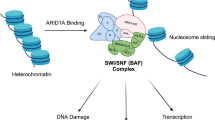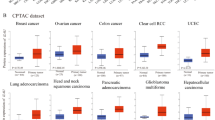Abstract
Objective
This study assesses TRAIL-R2 (TNF-related apoptosis-inducing ligand receptor 2) and BCL2 (B cell CLL/lymphoma 2) expression as well as CpG island methylation within the TRAIL-R2 promoter in ovarian serous tumors and primary and metastatic serous EOC (epithelial ovarian cancer).
Methods
RNA and DNA were obtained from women with normal ovarian tissues (n = 18), ovarian serous cystadenoma tumors (n = 11) and serous EOC (n = 16) using Trizol®. Quantitative PCR was performed to quantify the relative levels of TRAIL-R2 and BCL2. The methylation frequency of the TRAIL-R3 promoter was assessed using a methylation-specific PCR assay after DNA bisulfite conversion. Differences between the groups were evaluated using the χ 2, Mann–Whitney U or Kruskal–Wallis tests, as indicated.
Results
We identified TRAIL-R2 and BCL2 mRNA expressed in all ovarian tumor groups, and there were significant differences between the groups. Both genes had low expression levels in ovarian serous cystadenoma and primary EOC tumors when compared with metastatic EOC. Methylation of the TRAIL-R2 promoter was frequently observed in all groups; however, there were no statistically significant associations.
Conclusions
Primary EOC is associated with lower TRAIL-R2 and BCL2 expression levels, while metastatic EOC is associated with higher expression of these genes. Promoter DNA methylation was not related to this finding, suggesting there are other mechanisms involved in transcriptional control.




Similar content being viewed by others
References
Bai M, Papoudou-Bai A, Horianopoulos N, Grepi C, Agnantis NJ, Kanavaros P (2007) Expression of bcl2 family proteins and active caspase 3 in classical Hodgkin’s lymphomas. Hum Pathol 38:103–113
Bast RC Jr, Hennessy B, Mills GB (2009) The biology of ovarian cancer: new opportunities for translation. Nat Rev 9:415–428
Bevis KS, Buchsbaum DJ, Straughn JM Jr (2010) Overcoming TRAIL resistance in ovarian carcinoma. Gynecol Oncol 119:157–163
Braga L, Ramos A, Traiman P, Silva L, Silva-Filho A (2012) TRAIL-R3-related apoptosis: epigenetic and expression analyses in women with ovarian neoplasia. Gynecol Oncol 126:268–273
Bras M, Queenan B, Susin SA (2005) Programmed cell death via mitochondria: different modes of dying. Biochemistry 70:231–239
Debatin KM, Krammer PH (2004) Death receptors in chemotherapy and cancer. Oncogene 23:2950–2966
Degli-Esposti MA, Dougall WC, Smolak PJ, Waugh JY, Smith CA, Goodwin RG (1997) The novel receptor TRAIL-R4 induces NF-kappaB and protects against TRAIL-mediated apoptosis, yet retains an incomplete death domain. Immunity 7:813–820
Degli-Esposti MA, Smolak PJ, Walczak H, Waugh J, Huang CP, DuBose RF, Goodwin RG, Smith CA (1997) Cloning and characterization of TRAIL-R3, a novel member of the emerging TRAIL receptor family. J Exp Med 186:1165–1170
Elias A, Siegelin MD, Steinmuller A, von Deimling A, Lass U, Korn B, Mueller W (2009) Epigenetic silencing of death receptor 4 mediates tumor necrosis factor-related apoptosis-inducing ligand resistance in gliomas. Clin Cancer Res 15:5457–5465
Elmore S (2007) Apoptosis: a review of programmed cell death. Toxicol Pathol 35:495–516
Elrod HA, Fan S, Muller S, Chen GZ, Pan L, Tighiouart M, Shin DM, Khuri FR, Sun SY (2010) Analysis of death receptor 5 and caspase-8 expression in primary and metastatic head and neck squamous cell carcinoma and their prognostic impact. PLoS One 5:e12178
Falschlehner C, Emmerich CH, Gerlach B, Walczak H (2007) TRAIL signalling: decisions between life and death. Int J Biochem Cell Biol 39:1462–1475
Fariss MW, Chan CB, Patel M, Van Houten B, Orrenius S (2005) Role of mitochondria in toxic oxidative stress. Mol Interv 5:94–111
FIGO IFoGaO (2009) Clinical practice guidelines
Frankel A, Rosen K, Filmus J, Kerbel RS (2001) Induction of anoikis and suppression of human ovarian tumor growth in vivo by down-regulation of Bcl-X(L). Cancer Res 61:4837–4841
Fulda S, Debatin KM (2006) Extrinsic versus intrinsic apoptosis pathways in anticancer chemotherapy. Oncogene 25:4798–4811
Gronbaek KHC, Jones PA (2007) Epigenetic changes in cancer. APMIS 115:10
Hausmann M, Leucht K, Ploner C, Kiessling S, Villunger A, Becker H, Hofmann C, Falk W, Krebs M, Kellermeier S, Fried M, Scholmerich J, Obermeier F, Rogler G (2011) BCL-2 modifying factor (BMF) is a central regulator of anoikis in human intestinal epithelial cells. J Biol Chem 286:26533–26540
Hengartner MO (2000) The biochemistry of apoptosis. Nature 407:770–776
Hennessy BT, Murph M, Nanjundan M, Carey M, Auersperg N, Almeida J, Coombes KR, Liu J, Lu Y, Gray JW, Mills GB (2008) Ovarian cancer: linking genomics to new target discovery and molecular markers: the way ahead. Adv Exp Med Biol 617:23–40
Herman JG, Graff JR, Myohanen S, Nelkin BD, Baylin SB (1996) Methylation-specific PCR: a novel PCR assay for methylation status of CpG islands. Proc Natl Acad Sci USA 93:9821–9826
Hopkins-Donaldson S, Ziegler A, Kurtz S, Bigosch C, Kandioler D, Ludwig C, Zangemeister-Wittke U, Stahel R (2003) Silencing of death receptor and caspase-8 expression in small cell lung carcinoma cell lines and tumors by DNA methylation. Cell Death Differ 10:356–364
Igney FH, Krammer PH (2002) Death and anti-death: tumour resistance to apoptosis. Nat Rev Cancer 2:277–288
Imura M, Yamashita S, Cai LY, Furuta J, Wakabayashi M, Yasugi T, Ushijima T (2006) Methylation and expression analysis of 15 genes and three normally-methylated genes in 13 ovarian cancer cell lines. Cancer Lett 241:213–220
Jin Z, McDonald ER 3rd, Dicker DT, El-Deiry WS (2004) Deficient tumor necrosis factor-related apoptosis-inducing ligand (TRAIL) death receptor transport to the cell surface in human colon cancer cells selected for resistance to TRAIL-induced apoptosis. J Biol Chem 279:35829–35839
Kelly MM, Hoel BD, Voelkel-Johnson C (2002) Doxorubicin pretreatment sensitizes prostate cancer cell lines to TRAIL induced apoptosis which correlates with the loss of c-FLIP expression. Cancer Biol Ther 1:520–527
Khaider NG, Lane D, Matte I, Rancourt C, Piche A (2012) Targeted ovarian cancer treatment: the TRAILs of resistance. Am J Cancer Res 2:75–92
Kim K, Fisher MJ, Xu SQ, el-Deiry WS (2000) Molecular determinants of response to TRAIL in killing of normal and cancer cells. Clin Cancer Res 6:335–346
Lai JCWJ, Cheng YW, Yeh KT, Wu TC, Chen CY et al (2009) O6-methylguanine-DNA methyltransferase hypermethylation modulated by 17beta-estradiol in lung cancer cells. Anticancer Res 29:6
Li YYF, Hua Y, Lu W, Xie X (2009) Identification of suitable reference genes for gene expression studies of human serous ovarian cancer by real-time polymerase chain reaction. Anal Biochem 394:7
Livak KJ, Schmittgen TD (2001) Analysis of relative gene expression data using real-time quantitative PCR and the 2[−Delta Delta C(T)] method. Methods 25:402–408
Mahmood Z, Shukla Y (2010) Death receptors: targets for cancer therapy. Exp Cell Res 316:887–899
Malhi H, Gores GJ (2006) TRAIL resistance results in cancer progression: a TRAIL to perdition? Oncogene 25:7333–7335
Mellier G, Huang S, Shenoy K, Pervaiz S (2010) TRAILing death in cancer. Mol Asp Med 31:93–112
Meng CFZX, Peng G, Dai DQ (2009) Promoter histone H3 lysine 9 di-methylation is associated with DNA methylation and aberrant expression of p16 in gastric cancer cells. Oncol Rep 22:7
Min KJ, Jang JH, Lee JT, Choi KS, Kwon TK (2012) Glucocorticoid receptor antagonist sensitizes TRAIL-induced apoptosis in renal carcinoma cells through up-regulation of DR5 and down-regulation of c-FLIP(L) and Bcl-2. J Mol Med (Berl) 90:309–319
Nagaprashantha LD, Vatsyayan R, Lelsani PC, Awasthi S, Singhal SS (2011) The sensors and regulators of cell-matrix surveillance in anoikis resistance of tumors. Int J Cancer 128:743–752
Ouellet V, Le Page C, Madore J, Guyot MC, Barres V, Lussier C, Tonin PN, Provencher DM, Mes-Masson AM (2007) An apoptotic molecular network identified by microarray: on the TRAIL to new insights in epithelial ovarian cancer. Cancer 110:297–308
Pan G, Ni J, Wei YF, Yu G, Gentz R, Dixit VM (1997) An antagonist decoy receptor and a death domain-containing receptor for TRAIL. Science 277:815–818
Pavet V, Portal MM, Moulin JC, Herbrecht R, Gronemeyer H (2011) Towards novel paradigms for cancer therapy. Oncogene 30:1–20
Sheridan JP, Marsters SA, Pitti RM, Gurney A, Skubatch M, Baldwin D, Ramakrishnan L, Gray CL, Baker K, Wood WI, Goddard AD, Godowski P, Ashkenazi A (1997) Control of TRAIL-induced apoptosis by a family of signaling and decoy receptors. Science 277:818–821
Shivapurkar N, Toyooka S, Toyooka KO, Reddy J, Miyajima K, Suzuki M, Shigematsu H, Takahashi T, Parikh G, Pass HI, Chaudhary PM, Gazdar AF (2004) Aberrant methylation of trail decoy receptor genes is frequent in multiple tumor types. Int J Cancer 109:786–792
Suzuki HGE, Chen W, Anbazhagan R, Van Engeland M, Weijenberg MP et al (2002) A genomic screen for genes upregulated by demethylation and histone deacetylase inhibition in human colorectal cancer. Nat Genet 31:9
Taddei ML, Giannoni E, Fiaschi T, Chiarugi P (2012) Anoikis: an emerging hallmark in health and diseases. J Pathol 226:380–393
Taylor RC, Cullen SP, Martin SJ (2008) Apoptosis: controlled demolition at the cellular level. Nat Rev 9:231–241
Turker MS (2002) Gene silencing in mammalian cells and the spread of DNA methylation. Oncogene 21:5388–5393
van Noesel MM, van Bezouw S, Salomons GS, Voute PA, Pieters R, Baylin SB, Herman JG, Versteeg R (2002) Tumor-specific down-regulation of the tumor necrosis factor-related apoptosis-inducing ligand decoy receptors DcR1 and DcR2 is associated with dense promoter hypermethylation. Cancer Res 62:2157–2161
Walczak H, Degli-Esposti MA, Johnson RS, Smolak PJ, Waugh JY, Boiani N, Timour MS, Gerhart MJ, Schooley KA, Smith CA, Goodwin RG, Rauch CT (1997) TRAIL-R2: a novel apoptosis-mediating receptor for TRAIL. EMBO J 16:5386–5397
Wang X, Seed B (2003) A PCR primer bank for quantitative gene expression analysis. Nucleic Acids Res 31:e154
Wu Y, Alvarez M, Slamon DJ, Koeffler P, Vadgama JV (2010) Caspase 8 and maspin are downregulated in breast cancer cells due to CpG site promoter methylation. BMC Cancer. doi:10.1186/1471-2407-10-32
Yap TA, Carden CP, Kaye SB (2009) Beyond chemotherapy: targeted therapies in ovarian cancer. Nat Rev 9:167–181
Yerbes R, Palacios C, Lopez-Rivas A (2011) The therapeutic potential of TRAIL receptor signalling in cancer cells. Clin Transl Oncol 13:839–847
Acknowledgments
This work was supported by the Fundação de Amparo à Pesquisa do estado de Minas Gerais, FAPEMIG #PPM-CDS-00246-09, Coordenação de Aperfeiçoamento de Pessoal de Nível Superior, Capes and Conselho Nacional de Desenvolvimento Científico e Tecnológico, CNPq. The authors would like to thank Francisco de Oliveira Vieira for artwork help and the Pro-Rectory of Research of the Universidade Federal de Minas Gerais for additional financial support.
Conflict of interest
The authors have no conflicts of interest to declare.
Author information
Authors and Affiliations
Corresponding author
Rights and permissions
About this article
Cite this article
da Conceição Braga, L., Silva, L.M., Piedade, J.B. et al. Epigenetic and expression analysis of TRAIL-R2 and BCL2: on the TRAIL to knowledge of apoptosis in ovarian tumors. Arch Gynecol Obstet 289, 1061–1069 (2014). https://doi.org/10.1007/s00404-013-3060-0
Received:
Accepted:
Published:
Issue Date:
DOI: https://doi.org/10.1007/s00404-013-3060-0




